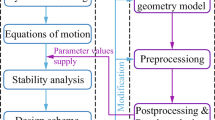Abstract
Finite element analysis (FEA) has been used to recapitulate the interactions between fixtures and components over the last decade. Most of the researches were focussed on the 3-2-1 fixture for components with regular geometry using point-to-point contact elements, where the fixture element is represented by a point-contacting component. Due to predicable behaviour of the fixture–component pair, such a point-to-point contact representation may be sufficient. However, when components with complex geometry, e.g. B-spline surfaces, which are widely used in the automotive and aero-engine industries, are of interest, the point-to-point method can no longer be satisfactory. This paper proposes a method of FEA on a system of a fixture and turbine blades by considering the complex contact geometry and complicated contact status of fixture–component pairs using surface-to-surface contact elements. A complete procedure of FEA modelling including geometry simplification, contact modelling, stiffness of locators, mesh generation, boundary condition and loading sequence is explained in detail. Having verified the FEA prediction of the elastic deformation with the displacement of the workpiece measured by coordinate measurement machines (CMMs), the influential factors of deformation, such as friction and machining directions, are analysed.
Similar content being viewed by others
References
Nee AYC, Whybrew K, Senthil Kumar A (1995) Advanced fixture design for FMS. Springer, Berlin Heidelberg New York
Li B, Melkote SN (1999) Improved workpiece location accuracy through fixture layout optimization. Int J Mach Tools Manuf 39(6):871–883
Amaral N, Rencis JJ, Rong Y (2005) Development of a finite element analysis tool for fixture design integrity verification and optimisation. Int J Adv Manuf Technol 25(5–6):409–419
Hamedi M (2005) Optimizing workholding efficiency through fixture function simulation. Int J Prod Res 43(13):2775–2788
Kaya N, Özturk F (2003) The application of chip removal and frictional contact analysis for workpiece–fixture layout verification. Int J Adv Manuf Technol 21(6):411–419
Liao YJG, Hu SJ (2000) Flexible multibody dynamics based fixture–workpiece analysis model for fixturing stability. Int J Mach Tools Manuf 40(3):343–362
Yeh JH, Liou FW (1999) Contact condition modelling for machining fixture setup processes. Int J Mach Tools Manuf 39(5):787–803
De Meter EC (1998) Fast support layout optimization. Int J Mach Tool Manuf 38(10–11):1221–1239
Satyanarayana S, Melkote SN (2004) Finite element modeling of fixture–workpiece contacts: single contact modeling and experimental verification. Int J Mach Tools Manuf 44(9):903–913
Siebenaler SP, Melkote SN (2005) Prediction of workpiece deformation in a fixture system using the finite element method. Int J Mach Tools Manuf 46(1):51–58
Hurtado JF, Melkote SN (1999) Workpiece–fixture static friction under dynamic loading. Wear 231(1):139–152
Wang Y, Chen X, Gindy QL (2003) Fixture evaluation based on CMM. In: Ford DG (ed) Laser metrology and machine performance VI (LAMDAMAP 2003). WIT Press, Southampton, UK, pp 231–241
Wang Y, Chen X, Gindy QL (2005) Fixturing error measurement and analysis using CMMs. J Phys: Conf Ser 13(1):163–166
Author information
Authors and Affiliations
Corresponding author
Rights and permissions
About this article
Cite this article
Wang, Y., Chen, X., Gindy, N. et al. Elastic deformation of a fixture and turbine blades system based on finite element analysis. Int J Adv Manuf Technol 36, 296–304 (2008). https://doi.org/10.1007/s00170-006-0841-7
Received:
Accepted:
Published:
Issue Date:
DOI: https://doi.org/10.1007/s00170-006-0841-7




